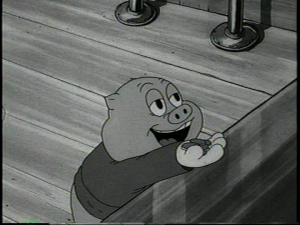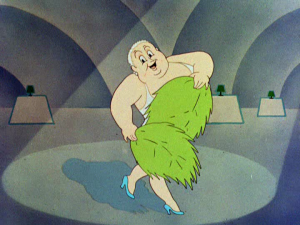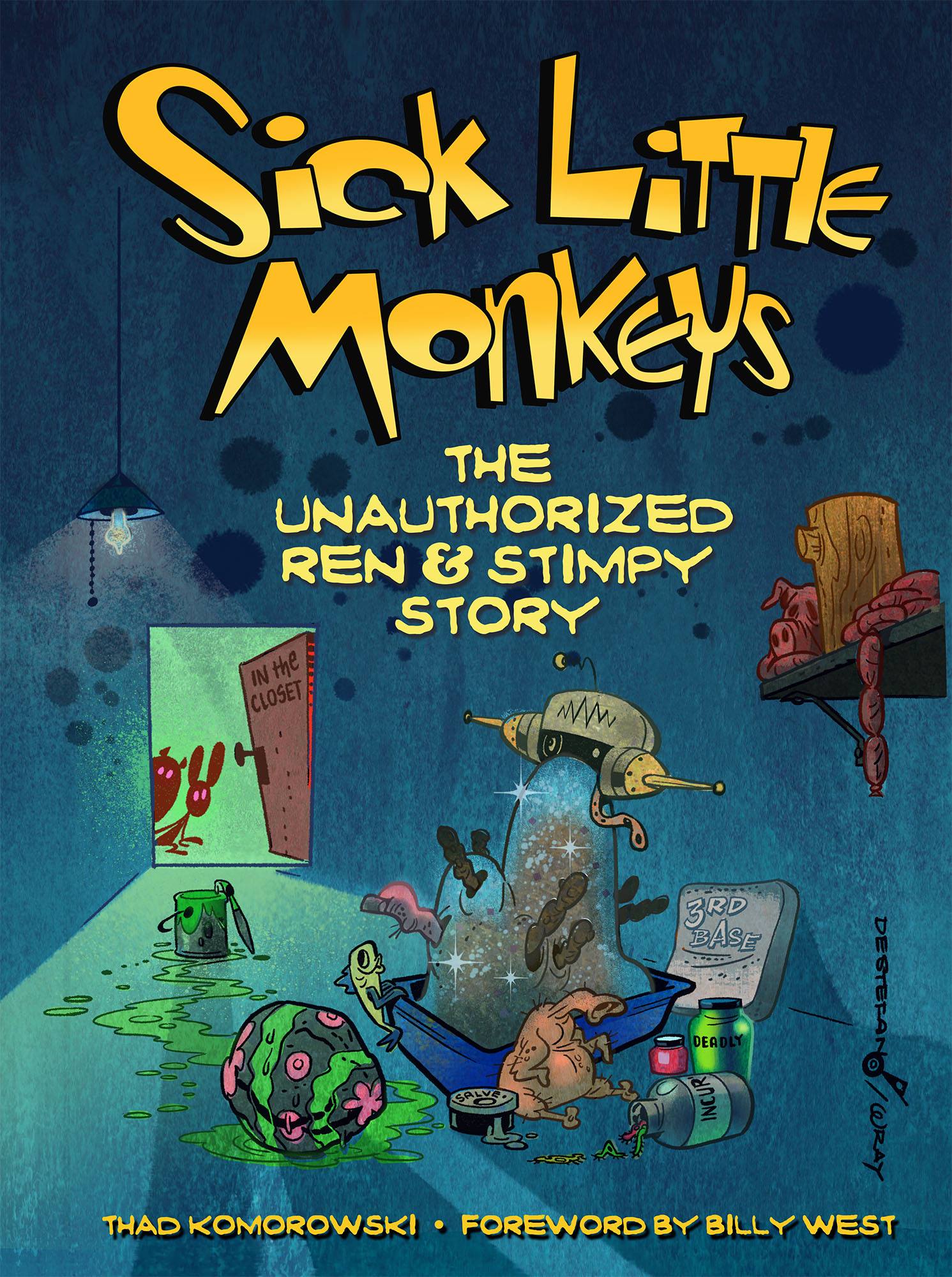Once again, this blog comes last as my disarrayed life settles. I’m laying the groundwork for a new book on a classic studio you all love, as well as an expanded, revised, hardback edition of Sick Little Monkeys. Those egregious typos will be eradicated, even more information will be added, and yes, a few errors will be corrected, thanks to Tom Minton and Stephen DeStefano for bringing them to my attention. (The most glaring, for the record: Ted Bakes One, the interstitial done by John Kricfalusi and Bill Wray for Channel Zero was made in 1981 and not 1979 as I state. And due to my mis-shuffling of sources and wording, I incorrectly stated that the Bakshi studio was located in Van Nuys during the first season of Mighty Mouse. It was in fact in North Hollywood. Bakshi, after he severed his partnership with John Hyde, relocated to Van Nuys for the second season.)
I also missed out, as did most of the online world it seems, on posting about the centennial of Bob Clampett’s birth, which fell on May 8th last week. Just as well, as I didn’t have much on my mind to say about him then, beyond what I commented on Mike Barrier’s site.
Mark Kausler, that great animator and historian whom I compared to Clampett as far as generosity and animation knowledge were concerned, further demonstrated his kindness by graciously pointing out, via e-mail, that I had flubbed one of my animator IDs years ago. In the Internet age, the single thing websites and blogs (authored by serious people anyway) have over print media is that misinformation can be corrected with the click of a button.
I’d been under the impression the animation of Porky Pig in the malt shop in Tex Avery’s important film The Blow Out, pictured above, had been by Chuck Jones and I stated so at least once without being corrected. Mark says the animation was actually done by Bob Clampett. He said he used the one piece of Clampett’s animation from the period that is verifiably his, the fat lady’s “Sally Rand” dance in (Page) Miss Glory, as reference. I value Mark’s opinion on these things more than anyone else, so I’m not going to second guess him or grandstand until he provides further evidence. If Mark Kausler says so, it’s true.
Clampett never had much to say about his actual work as a draftsman or an animator, be it in interviews or chitchat with those like Mark who knew him. Frankly, judging by the animation that’s verifiably his, he was a pretty damn good animator by 1936 standards, one who could illustrate real life in both the drawing and characterization, and on par with anything Jones was able to do at the time. (Well, from what Mark has told me is verifiably Jones’s anyway…) Certainly nothing to be ashamed of, so why would he write it off?
I can only guess that it’s because he clearly became increasingly disinterested in works that weren’t 100% attributable to his vision. That animation for Avery (and to a far lesser extent Jack King) was in response to another filmmaker’s direction. Certainly he’d acknowledge (as did the other guys) that he did important animation in Porky’s Duck Hunt, but that was an exception. Likewise, he became dismissive of his crew’s skills on the black-and-white Looney Tunes when he knew more money and artistic license was just across the lot. Whatever rough edges they have, a well-crafted entry like Porky & Daffy, Porky in Wackyland, or Porky in Egypt did not exist after the first year or two of Clampett’s tenure as a Warner director, when he clearly became exhausted with his surroundings.
To bring up another B.C. historical dilemma, where are the Clampett drawing from when he finally got his own “A” unit? I have seen plenty examples of Clampett’s draftsmanship from his black-and-white cartoons, and they are energetic and functional. But never a single one from his color cartoons, the “energy sketches” as described by Bob McKimson and Phil Monroe. Given Clampett took so much of his own (and other people’s) art with him to the grave, I can only suspect he was embarrassed by the haste and roughness of whatever drawings he did as a director in the ’40s. Again, they were probably nothing to be ashamed of. Friz Freleng’s own drawings exhibit similarities in their genuine, painstaking effort to get an emotion across. Both men also relied on other artists to pick up the drawing slack because their skills were better elsewhere – and both clearly knew what they were doing.
Given that level of personal investment, it’s therefore striking that so many Clampett cartoons really don’t hold up as wholes, yet I can’t bring myself to actively dislike them. Hare Ribbin’ and Draftee Daffy are two that come immediately to mind, to name two popular examples, that are so loaded with sloppy execution and mischaracterization that I really should be tearing them apart, but dammit, I can’t bring myself to do anything except adore them. (By the way, does anything go on in the latter beyond Daffy running around the house for four minutes?) Like Nick Ray, Clampett was a largely uneven filmmaker for a better part of his career, yet also charismatic and such a pure artist and entertainer that it’s easy to forgive any aesthetic blunders. Other directors may have been sturdier, but they were also more predictable. True, unpredictability doesn’t create greater art by default – but the heights of an artist’s peaks surely count for something.
I mean, what case can be made against the guy who gave the world this? Really?




Mark’s comments affected me, too, and made it clear how precious little of animation’s nuts-and-bolts history is adequately and clearly recorded. It seems that, everywhere one looks, there are missing links, gaps in otherwise-complete bits of information, and hearsay that has been promoted into fact.
In writing about Avery’s WB films, I’m trying to stay away from IDs, etc., unless I’m 101% sure about them. I look forward to the Irv Spence-era Averys, because his scenes, like Jim Tyer’s, go against the grain and are easy to ID.
All we can do is soldier on, with strong intentions and integrity, and know, as you say, that mistakes on the Internet are just a mouse-click away from deletion.
I don’t pretend to be 1/10th of the historian you are, Thad, but if any of us can put to rest misinformation, and deliver historical truth, on the record, we’ll have done something good for the world. It’s worth trying hard to achieve this goal, despite the odds.
I love how you were able to objectively point out that even Clampett’s films had flaws but also acknowledge that his charisma and sensibilities as an entertainer made up for whatever problems that were present in his weaker films. The great animation in “Buckaroo Bugs” really helped to keep my mind off the unprovoked, asshole for no reason version of Bugs Bunny and it would be nice if a lot of modern animation could even come close to having such good, appealing animation and drawings. He was able to get as much as he could out of Scribner, McKimson, Ross, and other animators that he worked with in his unit. I also like how you didn’t try to deify him and go overboard with whatever positive comments you had to say about the man. Appreciating an all around great director is one thing but trying to idolizing them is a huge disservice to not only the fans but to the director himself IMHO. Distinctions need to be drawn.
It also doesn’t surprise me that Clampett could draw pretty well, especially for his time. I saw a nice drawing he did of Beany and Cecil over at Jenny Lerew’s blog.
“The Great Piggy Bank Robbery” also ranks among my all-time favorite cartoons and right up there with “Northwest Hounded Police,” “Duck Amuck” and “One Froggy Evening” for me. It never gets old. No need to apologize for the mistake you made on misidentifying Clampett animation for Jones. I bet it happens to the best of animation historians and uber cartoon junkies. The first thing I thought when I saw that frame grab from “Bell Hoppy” was that it had to be Scribner drawing but for some reason I had doubted myself and Manny Gould’s name had popped into my head.
I suspect Clampett used to bring up Porky’s Duck Hunt not so much because of his drawings but the uniqueness (at the time) of gag behind the animation. Clampett wanted to take credit for some history.
Clampett’s 1939-40 period is like a wildman locked in the steel cage of the Katz unit. His 1937-38 efforts show both an energy and a story structure; for the most part in the ’39-40 efforts, sections of story are seemingly patched together in the same way the story would change in an early-30s Fleischer cartoon when a new animator took over the drawing. Leon’s decision in 1940 that all four units would now do both color and B&W cartoons was like a get out of jail card for Bob — his 1941-early ’42 shorts are slow, but the story structure, even when he went back to Porky (“Porky’s Pooch”) was far more fluid. His greatest cartoons combined the 1937-38 wildness with the vastly improved story construction, so that by the end of ’42 the animation was as wild or wilder than it had ever been, but in their own little world, the wildness made sense.